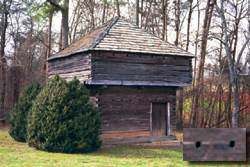The Trail of Tears is a tragic tale of force winning over decency and power winning over justice. While the focus today remains on the route traveled and the journey itself, for eight years prior to the event Cherokee were confronted with their future on a daily basis. Illegal stockades were built on Cherokee land, intended to house Cherokee people long before their forced journey on "The Trail of Tears."
"Cherokee Forts are built "
Earliest of the forts in Georgia, known as Camp Hinar Sixes, was built in September, 1830, shortly after the Congress passed the Indian Removal Act of 1830. This camp was used to house members of the infamous Georgia Guard who took it upon themselves to brutalize the Cherokee even though at this time the settlers were illegal immigrants. In one instance in 1830, during the construction of the camp the Guard, without provocation, destroyed equipment that Cherokee miners were using to extract gold. The Georgia Guard did not officially exist until December of that year.
After Cherokee Nation vs. Georgia, in which the Supreme Court refused to hear a case about Georgia extending its laws on the Cherokee, construction on the forts sped up. A year later the settlers were stunned when the Court ruled that Georgia could not extend its laws on a sovereign nation such as the Cherokee, but were again heartened by Andy Jackson's rumored statement (he probably never said it), "Well, John Marshall has made his decision, now let him enforce it."
"Georgia Settlers and Removal "
Settlers were greatly divided on the issue of removal. Families that had lived in the Nation before the Georgia Gold Rush tended to be more supportive of the Cherokee. One reason for the strong bond was the acceptance of them by the tribe. White settlers were easily accepted into Cherokee society. The reverse was not true. In general, Georgians viewed the Cherokee as somewhat higher on the social level than slaves, but not much. Another reason that settlers were greatly divided was the support Cherokee had given struggling early settlers in their time of need.
Some settlers would taunt the Cherokee, telling them the forts were to be their new home. With great concern, Principal Chief John Ross and Whitepath, among others, journeyed to Washington to meet with Jackson. Jackson hypocritically told them "You shall remain in your ancient land as long as grass grows and water runs." In early 1835, before the Treaty of New Echota, work began on road improvements to move the Cherokee to the starting point for their removal.
"Military Operations begin "
After Major Ridge and other members of the Treaty Party sign the Treaty of New Echota, The Principal People hoped their leaders would get it modified so they might stay on their ancestral land. Even while a Cherokee delegation was in Washington Governor George Gilmer of Georgia and Secretary of War Joel Poinsett were plotting the invasion.
Local operations began on May 18, 1838, mostly carried out by Georgia Guard under the command of Colonel William Lindsey. The first Cherokee round-up under orders from United States General Winfield Scott started on May 25, 1838 with General Charles Floyd in charge of field operations.
General Scott was shocked during a trip to inspect Fort New Echota when he overheard members of The Guard say that they would not be happy until all Cherokee were dead. As a result, he issued meticulous orders on conduct and allowed actions during the action. Troops were to treat tribal members "with kindness and humanity, free from every strain of violence." Each Cherokee was to receive meat and flour or corn regardless of age. Scott's orders were disobeyed by most troops that were not directly under his control.

"Occupying the Forts "
Some Cherokee reported to the forts, not knowing the fate that awaited them, simply because John Ross had told them this is what they should do. Others stayed and were working in the fields when the soldiers came. The Georgia Guard had identified Cherokee homes. Aided by troops from Alabama, Florida, North and South Carolina, and Tennessee, Georgia militia would typically approach a home and enter the house. The resident(s) would then be forced to leave. The amount of time given residents to collect belongings varied greatly.
Some were forced to leave immediately while others had enough time to sell valuables to local settlers at bargain rates. There are numerous instances where settlers attempted to intervene when the Guard was being particularly rough on a family.
Conditions at the forts were horrible. Food intended for the tribe was sold to locals. What little the Cherokee had brought with them was stolen and sold. Living areas were filled with excrement. Birth rates among the Cherokee dropped to near zero during the months of captivity. Cherokee women and children were repeatedly raped. Soldiers forced their captives to perform acts of depravation so disgusting they cannot be told here. One member of the Guard would later write, "During the Civil War I watched as hundreds of men died, including my own brother, but none of that compares to what we did to the Cherokee Indians."
"Towards the Trail "
For a number of reasons nothing seemed to go right during the removal. The round up that began in mid-May was completed on June 2, 1838. Some Cherokee were forced to live in these conditions for up to five months before the start on the journey whose name is "Nunna daul Tsuny (Trail Where They Cried)."
As many as one-third of the 4,000 deaths as a direct result of the removal can be attributed to conditions in the prisons. Unfortunately, many of the Cherokee Removal Forts are unmarked and lost to time.





























No comments:
Post a Comment